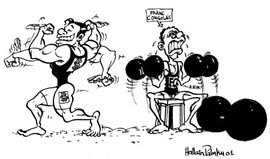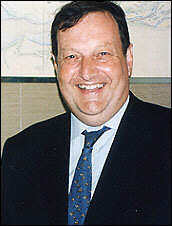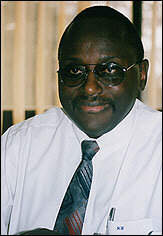 FINANCE: CURBING INFLATION FINANCE: CURBING INFLATION |
Finance | Banking
For the DRC to emerge from its economic depths and debts, monetary liabilities and instabilities will have to disappear. Curbing the constant threat of hyperinflation would in this case be a good start.
Six months after Joseph Kabila came to power, according to the Consumer Price Index (IRES- Kinshasa University), the Congolese Franc performed relatively well, maintaining certain stability compared to the US Dollar. The consolidation of this stability will in turn stop the inflation cycle. In this respect, Mr. Kabila's technocratic government has good reasons to be proud for bringing inflation down to 136% compared to an average of 214,4% for the period 1997-2000.
The population was able to buy meat and milk again. The importance of this cannot be emphasized enough, as it was not long ago most Congolese households could not even afford such products. It was indeed the country as a whole benefiting from the currency's appreciation with many Congolese sectors, such as Transport that saw gasoline prices went down from 280 CF/liter to 210 CF/liter, seeing significant changes for the good.
 SETTING MONETARY STABILITY SETTING MONETARY STABILITY
Mr. Kabila rightfully recognized that the State's budget was the main cause for distress in public finances. Expressed in terms of GDP, over the past three years, public revenues averaged 4.7%, whereas expenditures accumulated to 6.3%. Fiscal pressure was fixed around 4.5% per year, forcing the State to constantly rely on credits from the banking system to cover its investment and operational needs. Not being able to borrow from international markets, the State swallowed most financial resources available on the domestic market at an average of 82.6% of the banks' assets.

When coming to power, Mr. Kabila instantaneously departed from his father's objection to the deployment of UN forces and negotiated zestfully, but certainly not blindly, what looks to be a lasting peace agreement. With the dawn of a more peaceful era for the DRC, the present financial authorities have effectively put an end to the financial hemorrhage caused by the war effort.
Furthermore, since he was sworn into office, the present Minister of Economy, Finances and Budget, Mr. Freddy Matungulu Mbuyam Ilankir - a former member of the International Monetary Fund - decided that his main priority would be to clean up public finances. He assured that "any action implying that we live above our means will be, from now on, something of the past". With this aim in mind, all financial institutions are to serve one goal: the reconstruction of the DRC.
 PRINTING CURRENCY HAS COME TO A HALT PRINTING CURRENCY HAS COME TO A HALT
Among the efforts the Government has made its decision of not minting any more currency stands out.
Today the "Hôtel de la Monaie" (the Mint), the institution under the Central Bank in charge of printing currency, does not supply the Government with large quantities of money anymore. In the past the Government used this technical institution under the Central Bank to intervene in political coalitions engrossing the pockets of certain politicians.
back to the top
 A CONVALESCING BANKING SYSTEM A CONVALESCING BANKING SYSTEM |
A DRC paradox is that the country only has 25 banking offices for a population of more than 50 million people.

Mr. Laloux, General Director of the Banque Commerciale du Congo (BCDC) and a pioneer in the Congolese banking system, explains, "a bank is a service company whose role is to collect savings and relocate them. If the clients are not doing well, the banking system cannot do but badly". This explains the important losses registered by the BCDC, whose level of activities decreased by 83% and many branches had to be closed down. | Hence, for the time being, the DRC banking activities are mainly limited to cashier operations. The dramatic reduction of "letters of credit", a product commercial banks were specialized in, can be explained by the reduction of the country's economic activities, especially because they used to fund agro-industrial products such as coffee, wood, rubber and cocoa. Since the bulk of these products are produced in rebel territory or where military operations are intense (the Equator and Oriental provinces or the old province of Kivu), banks based in Kinshasa do not have any access to them.
 THE CONGOLESE BANKING SYSTEM REACHING NEW DYNANISMS THE CONGOLESE BANKING SYSTEM REACHING NEW DYNANISMS
In order to initiate the take off of the economy still plenty of things need to be done, and, as is becoming clear, in particular a revamp of the Congolese banking system.
It is indeed quite commendable that since the start of 2001, despite the Congolese banking sector's predicaments, these efforts have, little by little, given positive results.

While waiting for things to return to normal, what is clear is that the three largest commercial banks operating in Congo - i.e. BCDC, l'Union des Banques Congolaises (UBC) and the Banque Congolaise de Développement (BCD) - were all created in 1997 under the impulse of the regime of L.D. Kabila. In most cases, they try to be more imaginative than operational. For instance at the beginning of this year, the BCDC in association with the Western Union Group, launched a new product, financial messenger services, which was also started by the UBC. The BCD has furthermore tried to be more proactive vis-à-vis its clients. Considering that the environment might change from one day to the next it created financial services with a life span of three months. "We try to be imaginative in adapting to new circumstances, because the situation changes all the time. We have to remain alert anticipating our clients' needs in order to better respond to their demands" declared the Vice-President of the BCD, Mr. Christian Kamanzi Munhindo.
For the time being, commercial banks attain most of their profits from their clients' overdrafts. The majority of clients are State companies, although there are some private ones. This is working rather well because most of the Congolese firms have an important need of working capital. Through this practice banks obtain 60% of their present revenues.
The Vice-President of the BCD, Mr Christian Kamanzi, reveals some encouraging signs. " I do not see any increase of my deposits and neither do I see an increase of my revenues. Nevertheless, the working environment has changed a lot. We feel more at ease, the legislation today is less constraining than the one used to have..."
To all potential investors willing to come to the D.R of Congo, the Governor of the Central Bank advises: "My message is that all these things come by stages. The first thing is to study the essence of the economy. We must reassure investors that they can earn from their investments and repatriate their profits. In our exchange regulations, investors can repatriate investment and profits. The Central Bank just requires a declaration for statistical purposes. This is important for investors in case of conflict. Last week we just passed a law enabling the creation of an arbitrage court. This court will help in settling disputes much faster. We have recently published the investment code in conjunction with the mining code, because when we think of Congo we also think of diamonds, gold, copper, cobalt, etc".
"This is the time for investors to position themselves in Congo. We have everything that is needed to build a successful future. We soon hope to have a positive growth rate as high as 8% to 10 %".
|

